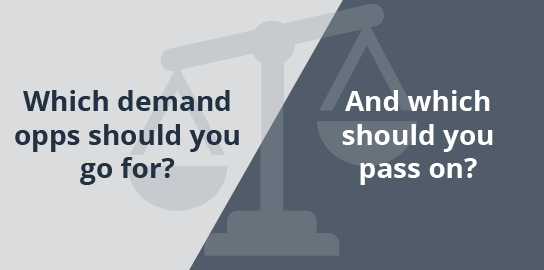B2B marketers are always looking for ways to reach their target audience and drive more demand. Simultaneously, there are tons of vendors and media that sell opportunities to drive that demand — that could be ad buys on a cost per click (CPC) or cost per impression (CPM) basis, opportunities to participate in events/conferences where your audience will be, or a number of other possibilities.
The decision of which opportunities to go for and which to pass on can be tough for marketers to evaluate because on the surface, they’re often not an apples to apples comparison.
In this post, we’ll discuss how to evaluate the various demand opportunities as objectively and as data-driven as possible.

1. Identify CPL (CPL)
Cost per lead is a good starting point for evaluating demand opportunities.
Business economics help marketers figure out the maximum they are willing to pay per lead. This is calculated by starting with desired profit margins, and then backing out all the way to lead generation: profit margin > deal size > win rate > opp conversion rate > cost per lead. If a company can stay within this CPL ceiling, and if everything goes down the funnel as expected, a company will successfully achieve its goals.
While demand opportunities are increasingly using CPL pricing models, the majority still operate on a CPC or CPM basis. Therefore, you need to know how to convert CPC and CPM models to CPL.
1.a. CPC-to-CPL
For example, let’s say you set a total campaign budget at $ 1,000 and you set your max bid for $ 10 per click. Assuming your ads are good (e.g. relevant content), you would expect at least 100 clicks. Because your bid is actually a ceiling, you likely will pay less than $ 10 per click and end up with greater than 100 clicks. The next step is calculate your click to lead conversion ratio. Out of those 100 clicks, how many actually become leads? To calculate this, you can look at past performance in your attribution data. Alternatively, channel or web analytics can tell you a click to form fill conversion rate (which may be close enough if you have a short marketing funnel).
1.b. CPM-to-CPL
If you’re bidding on CPM, you need to add one more step. You must calculate how many impressions it takes, on average, to generate one click. And then you can proceed to calculate how many of those clicks will become leads.
Note that the method in which you bid may alter how the ad platforms algorithm decides to deliver your ads. If you’re paying on a cost per click basis, the ad platform may optimize ad delivery for clicks, whereas if you’re paying on a cost per impression basis, it may not optimize for clicks.
2. Identify Cost Per Qualified Lead (CPQL)
Cost per lead, by itself, can be deceiving. If you’re paying a really low CPL, but the percentage of those leads that are actually quality leads are also low, it may not end up being a cost effective opportunity. On the other hand, a high initial cost per lead may end up being a decent opportunity if every or nearly every lead is high quality. To do this, we need to figure out the cost per qualified lead.
Now that you can calculate CPL no matter the pricing model, the next step is to figure out the quality of the leads that you will potentially be getting from your demand opportunity. Not all channels are the same, not all media are the same, not all audiences are the same.
Until you’ve run a test with that opportunity or a similar one, it can be tough to predict exactly how an audience will perform. Do your research and ask questions to find out what percentage of the leads that you’ll get will meet your qualification criteria. Is there a way that you can only pay for qualified leads? Can you use your qualification criteria to inform the targeting?
Depending on the opportunity and the information provided, this step can be a difficult task to get accurate.
3. Evaluate Channel Lead-to-Opp Conversion Rate
Even once you’ve calculated a CPQL, there are more factors to consider. After all, leads themselves (even qualified leads) aren’t valuable to a business — customers are.
When you look at the buyer funnel, the next step is converting the qualified leads into sales opportunities.
One of the most effective ways to break down your overall lead-to-opp conversion rate is by channel. A lead created from a media buy, for example, is probably not going to convert at the same rate as a lead created at a user conference.
An attribution solution allows marketers to break down their marketing performance by channel. Using a cross-channel lead report and a cross-channel opportunity report, you can calculate the historical conversion rate for each channel. Even better, if you have predictive analytics, use your predicted lead-to-opp conversion rate for an even more accurate understanding of how leads move down the funnel.
If you have one demand opportunity, which has a historical channel lead-to-opp conversion rate of 5% and another opportunity that has a rate of 10%, the second opportunity is a better option, even if the CPL is a little more expensive.
Another factor to consider in this stage is timing. Will this demand opportunity put your sales development team over their capacity? The longer it takes for the sales team to reach out to net new leads, the less likely they will convert into opportunities.
4. Evaluate Channel Win Rate
For many marketing organizations, getting to sales opportunity is as far down the funnel as they go. But for revenue-driven marketers, if you truly want to evaluate using the entire funnel, you must also consider the channel win rate when evaluating your options.
When looking at your attribution data, filter your closed opportunities by touchpoint channel. Within a set timeframe, count how many closed opportunities had a touchpoint from the channel that you want to analyze; then, count how many closed-won opportunities had a touchpoint from the same channel. Closed-won divided by total closed gives you your channel win rate. Read more about win rate analysis.
5. Adding It All Up
So now you have your CPL, your CPQL, your channel lead-to-opp conversion rate, and your channel win rate.

With a bit of math, you get your estimated cost per customer for that demand opportunity. Is that number something you’re willing to pay? If it is, go for it.
As you can see, it’s pretty straightforward. The bigger challenge, however, is getting accurate conversion rates throughout the funnel.
How to get accurate conversion rates throughout the buyer funnel
Getting accurate data starts with full-funnel marketing measurement, through an advanced attribution solution. This tracks buyer touchpoints at every stage — leads, opps, and closed-won customers — and from every source at multiple levels of granularity.
With this level of accuracy and granularity, steps 3 and 4 are possible and the conversion rates can be used with confidence. Furthermore, as mentioned in step 3, this process becomes even more precise with the use of predictive analytics. Through aggregated data and machine learning, a predictive engine can give a better prediction of stage conversion compared to historical data alone.
What happens if you’ve never used a channel before? How do you get the historical data necessary for steps 3, 4, and 5? As machine learning gives rise to a growth in predictive analytics, marketers will be able to tap into aggregated databases to see how similar organizations fared in similar situations. Alternatively, marketers can look to benchmark reports or ask their fellow marketers who may have experience using specific channels or media.
As you can see, accurately evaluating demand opportunities requires data throughout the entire funnel. For data-driven marketers who want to maximize their likelihood of success, going through the full process is well worth the time investment.
If you want to learn more about full-funnel marketing and full-funnel measurement, check out the Definitive Guide to Pipeline Marketing.
Business & Finance Articles on Business 2 Community
(94)





